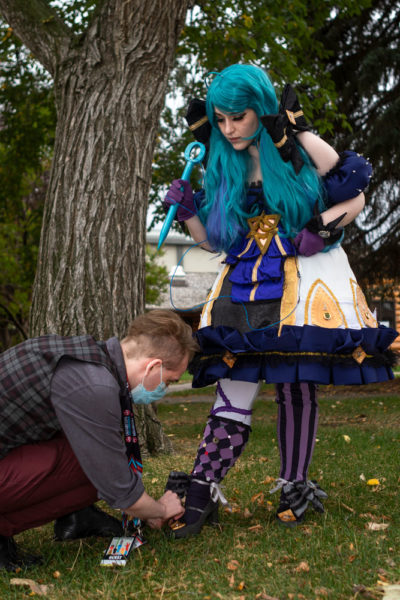Local cosplay artist invited to Calgary Expo as featured guest, contest judge
By John Watson Local Journalism Initiative Reporter

John Watson Photo
With the Calgary Comic and Entertainment Expo back in gear, fans, artists and cosplayers alike jumped at the chance to return to the in-person convention Sept. 10 to 12.
Among the cosplayers and costumers was Autumn Desjardins, though now residing in Calgary, originally hails from Strathmore.
Desjardins had been invited to the convention as a featured guest as well as a judge for the local costume contest.
“I never thought it would happen, so when I got an email in January, I was just like, ‘wait, what? Can someone please read this for me? Make sure I’m not reading this wrong?’” she said regarding the invitation.
The 2021 expo marked her first time attending as an invited guest as opposed to purchasing a ticket.
During the convention, Desjardins hosted a panel discussion to talk about her experiences as a cosplayer and what it takes to break into the art form.
“When I started, tutorials were few and far between. You had to learn everything on your own or YouTube something very specific and hope somebody made a tutorial for it,” she explained.
“Nowadays there are resources everywhere. There are cosplayers who make tutorials on how to do things, make patterns for specific characters … you can go on YouTube and you can find how to do anything and everything.”
“Cosplayer” is a term used for someone dressing up as, and often acting like a character from popular fiction such as cinema, television, comics and video games.
The term was coined in 1984 and has seen rapid growth both as a hobby and as a profession beginning in the 1990s.
Though it was originally a significant aspect of popular culture in Japan and East Asia, the practice has swelled in North America, gaining popularity and notoriety post 2010.
“It was so much fun getting to see other people, people recognizing me and getting to talk about it. That was really cool, then I got hooked from there,” said Desjardins about her own introduction to cosplay.
She said she has spent the last eight years working on cosplay both as a hobby, as well as to enter competitions.
“I started competing around the same time I started making costumes because I’m quite a competitive [person]. I wanted to keep building things and get better and better at it.”
She began competing at 14 and moved to the “masters” division at 16, which meant she began going head to head with professional cosplayers and costume makers.
“In 2019, my partner and I qualified to be Team Canada in the Netherlands to compete against 20 other countries … during COVID-19 I also represented Canada in Switzerland for an international contest online.”
“I’m still as hard on myself as I was when I started, so I just thought this was the only way I can make it better and keep growing.”
She adds two of the more challenging aspects of cosplay become eyesight and mobility once in character. Though this challenge does not apply to all costumes, it is often found with characters sporting elaborate suits of armour.
To aid with that problem, many cosplayers, Desjardins included, travel with “handlers” to assist with supporting the costume, carrying things and ensuring the cosplayer doesn’t walk into walls or people.
“I know people who build costumes with three pieces of fabric and that’s it and I know people who will spend two years on a costume. It really depends on what you want to do,” she said.
Desjardins added with every costume she creates, she tries to learn a new skill. Depending on what she’s up to, this can range from sewing, to leatherworking, to robotics coding.
She said that through it all, a great teacher along the way has been numerous failures and malfunctions.
“One of the best things that people can do is fail. Every time you fail at something, you learn something from it. Say you built something and then it falls apart. Well, next time, you don’t use hot glue, you use super glue.”
“Making mistakes is not a bad thing, it’s an important thing.”
